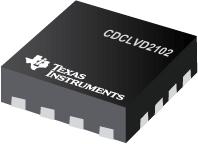●The CDCLVD2102 clock buffer distributes two clock inputs (IN0, IN1) to a total of 4 pairs of differential LVDS clock outputs (OUT0, OUT3). Each buffer block consists of one input and 2 LVDS outputs. The inputs can either be LVDS, LVPECL, or LVCMOS.
●The CDCLVD2102 is specifically designed for driving 50- transmission lines. If driving the inputs in single ended mode, the appropriate bias voltage (VAC_REF) should be applied to the unused negative input pin.
●Using the control pin (EN), outputs can be either disabled or enabled. If the EN pin is left open two buffers with all outputs are enabled, if switched to a logical "0" both buffers with all outputs are disabled (static logical "0"), if switched to a logical "1", one buffer with two outputs is disabled and another buffer with two outputs is enabled. The part supports a fail safe function. It incorporates an input hysteresis, which prevents random oscillation of the outputs in absence of an input signal.
●The device operates in 2.5V supply environment and is characterized from –40°C to 85°C (ambient temperature). The CDCLVD2102 is packaged in small 16-pin, 3-mm × 3-mm QFN package.
● Dual 1:2 Differential Buffer
● Low Additive Jitter <300 fs RMS in 10-kHz to 20-MHz
● Low Within Bank Output Skew of 15 ps (Max)
● Universal Inputs Accept LVDS, LVPECL, LVCMOS
● One Input Dedicated for Two Outputs
● Total of 4 LVDS Outputs, ANSI EIA/TIA-644A Standard Compatible
● Clock Frequency up to 800 MHz
● 2.375–2.625V Device Power Supply
● LVDS Reference Voltage, VAC_REF, Available for Capacitive Coupled Inputs
● Industrial Temperature Range –40°C to 85°C
● Packaged in 3mm × 3mm 16-Pin QFN (RGT)
● ESD Protection Exceeds 3 kV HBM, 1 kV CDM
● APPLICATIONS
● Telecommunications/Networking
● Medical Imaging
● Test and Measurement Equipment
● Wireless Communications
● General Purpose Clocking



